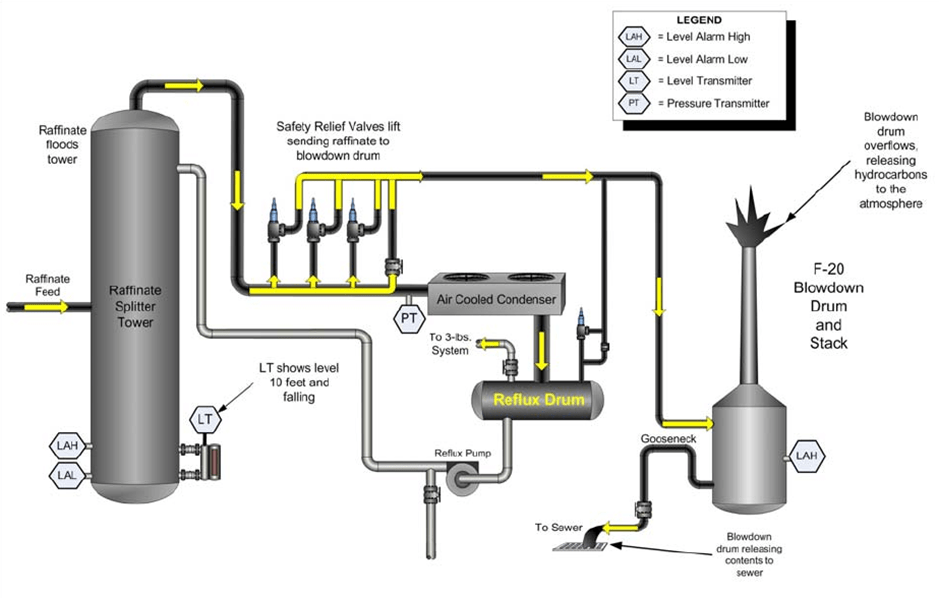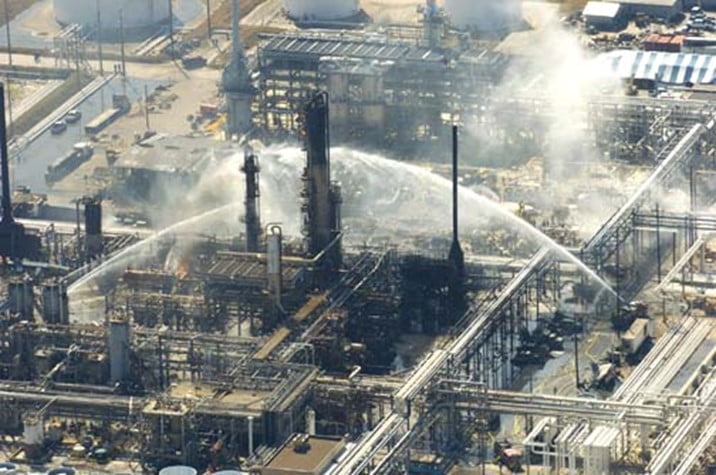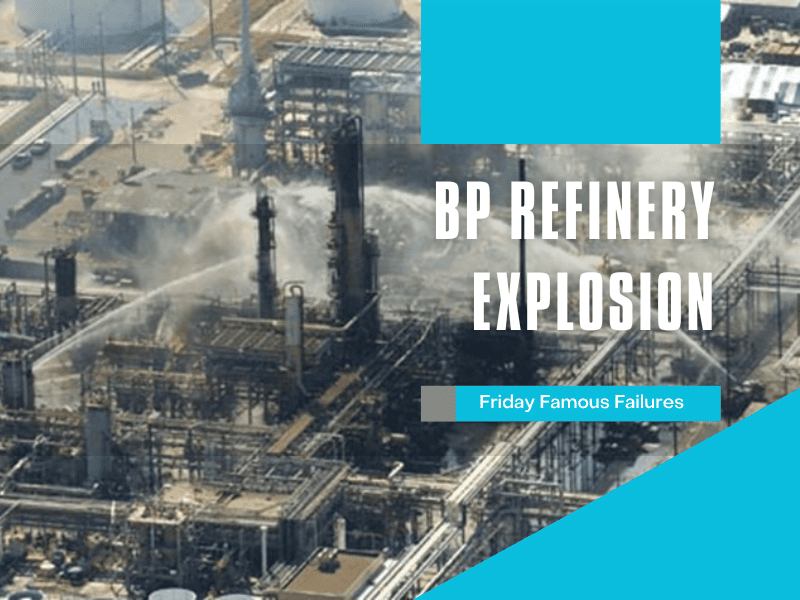On the morning of March 23, 2005, operators at the BP Texas City Refinery began the startup of the isomerization (ISOM) unit, a process that had been delayed from the previous day. The ISOM unit increases the octane level of gasoline, a routine but potentially hazardous operation due to the flammable nature of the hydrocarbons involved.
The startup process involved the filling of a raffinate splitter tower with liquid hydrocarbons. However, due to a combination of factors, including misinterpretation of level indicators, the tower was overfilled. The excess liquid and vapor hydrocarbons were vented from the tower to a blowdown drum, which quickly filled to capacity. The excess was then vented to an atmospheric stack, a piece of equipment dating back to the 1950s.

Figure 1 – Raffinate splitter tower overfilled, releasing flammable hydrocarbons into the environment through the blowdown stack
The stack, designed to handle gases, not liquids, began to discharge a geyser-like release of flammable liquid and vapor hydrocarbons into the surrounding area. This created a large vapor cloud, approximately 200 feet in diameter, which began to spread across the refinery.
The vapor cloud found an ignition source – most likely a running vehicle or a spark from a nearby contractor’s trailer – and ignited. The resulting explosion was equivalent to approximately 1,000 to 2,000 kilograms of TNT, and it was felt up to five miles away. The explosion caused extensive damage to the ISOM unit and surrounding facilities, and the ensuing fires burned for several hours.

Figure 2 – Fire-extinguishing operations after the Texas City refinery explosion. The large structure in the center is the raffinate splitter tower; the thinner structure to the right is the blowdown stack which overfilled
The explosion resulted in 15 fatalities, all of whom were working in or around contractors’ trailers located near the ISOM unit. Over 180 people were injured, many seriously. The explosion also caused significant damage to the refinery and resulted in financial losses estimated to be in the hundreds of millions of dollars.
The Texas City Refinery explosion was a catastrophic event that highlighted the potential dangers inherent in the oil and gas industry. The lessons learned from this incident have led to significant changes in safety practices and regulations, with the aim of preventing similar incidents in the future.
Investigation and Root Causes
The U.S. Chemical Safety and Hazard Investigation Board (CSB) conducted a comprehensive investigation into the incident. The CSB identified several key factors that contributed to the disaster:
- Poor Safety Culture: The CSB found that BP had a poor safety culture, with an emphasis on personal safety over process safety. This meant that while minor injuries were reduced, major hazards were not adequately identified or controlled.
- Inadequate Training and Supervision: The operators involved in the ISOM startup were inadequately trained and lacked sufficient supervision. This led to the misinterpretation of the level indicators and the overfilling of the distillation tower.
- Outdated Equipment: The blowdown drum and vent stack used in the ISOM unit were outdated and did not meet recognized industry standards. Modern flare systems would have safely burned off the excess hydrocarbons and prevented the explosion.
- Inadequate Safety Systems: The refinery lacked sufficient safety systems, such as automatic shutdown systems and alarms, which could have prevented the overfilling of the distillation tower.There were numerous changes in response to the explosion, some of which are listed below.
- Enhanced Process Safety Management (PSM)
The Occupational Safety and Health Administration (OSHA) revised its Process Safety Management (PSM) standard in response to the Texas City incident. The updated PSM standard now requires companies to conduct regular audits, provide comprehensive employee training, and implement robust management of change procedures. The standard also mandates thorough process hazard analyses, including the identification and evaluation of potential consequences of failures in process controls. - Equipment Upgrades
The Texas City explosion highlighted the dangers of outdated equipment. The blowdown drum and vent stack involved in the incident were replaced industry-wide with flare systems, which safely combust and disperse vapors, reducing the risk of similar incidents. This change was a significant step forward in ensuring that equipment used in refineries meets the highest safety standards. - Improved Safety Culture
The incident underscored the importance of a robust safety culture within organizations. Companies are now more focused on fostering a culture where safety is prioritized over operational efficiency. This includes encouraging employees to report potential safety issues and ensuring that these reports are addressed promptly and effectively. Many companies have also implemented behavior-based safety programs to further promote a safety-first mindset among employees. - Effective Risk Communication
The Texas City explosion highlighted the need for effective risk communication. Engineers and operators must have a clear understanding of the potential risks associated with their work. This has led to the development of more comprehensive training programs and improved communication tools. Many companies have also implemented safety briefings before the start of any high-risk operation, such as the startup or shutdown of a unit. - Increased Regulatory Oversight
The incident led to increased regulatory oversight in the industry. Regulatory bodies like OSHA have increased their inspection frequency and rigor, and penalties for non-compliance have become more severe. The Chemical Safety Board (CSB) also gained increased prominence and authority, conducting thorough investigations of industrial accidents and making recommendations for safety improvements.
Conclusion
The Texas City Refinery explosion was a tragic event that highlighted the potential dangers inherent in the oil and gas industry. However, the lessons learned from this incident have led to significant improvements in safety codes and industry practices. While the industry continues to strive for zero incidents, the changes implemented in the wake of the Texas City explosion have undoubtedly made the oil and gas industry safer.








Working in the refinery at the time, I was a witness to that event. Seeing people you know being lifeflighted out gives you a whole new perspective on safety. This tragedy changed my perspective on how I thought about safety, especially process safety, and what I was willing to accept going forward.
One of the culture issues that led to this event was weakness, both the company and union failed to hold employees accountable, even when they were clearly incompetent.